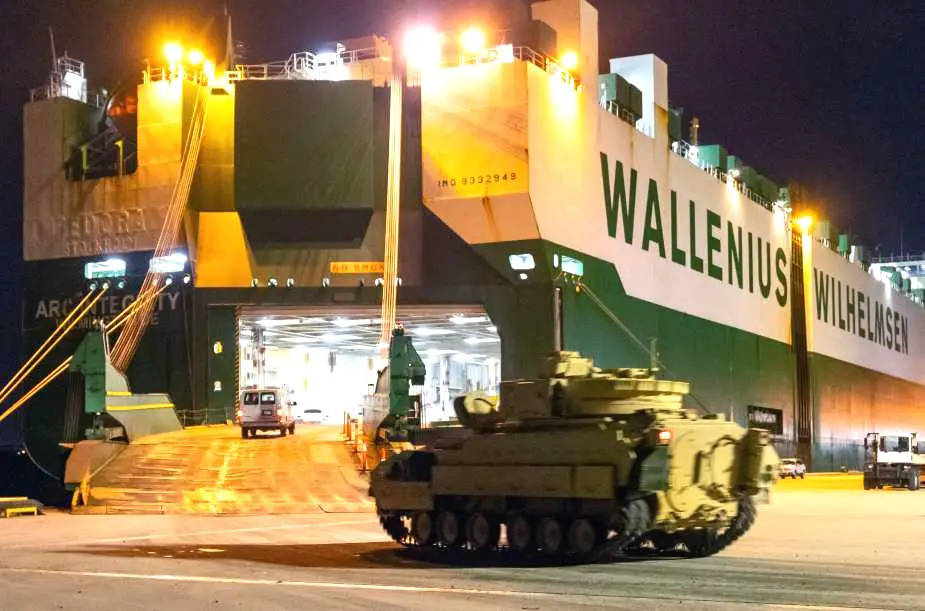Breaking news
40 NATO and European National Armaments Directors meet in support of Ukraine.
National Armaments Directors from more than 40 countries, the European Union, and NATO gathered on September 27 in Brussels, Belgium, under the auspices of the Ukraine Defense Contact Group to further ongoing efforts aimed at collaboratively solving industrial base and sustainment challenges in support of Ukraine. Led by Under Secretary of Defense for Acquisition and Sustainment William LaPlante, the session was the sixth meeting to date.
Follow Army Recognition on Google News at this link

A Bradley fighting vehicle is loaded onto the ARC Integrity vehicle carrier at the Transportation Core Dock in North Charleston, S.C., on Jan. 25, 2023. More than 60 Bradleys were shipped by U.S. Transportation Command as part of the U.S. military aid package to Ukraine (Picture source: US DoD/Oz Suguitan, Transportation Command)
Last week's forum came on the heels of the 15th meeting of the full UDCG hosted by Secretary of Defense Lloyd Austin a day earlier in Ramstein, Germany. "Ukraine's progress is a testament to the fighting spirit of its people," Austin said to ministers of defense and senior military officials. "But Ukraine's recent gains also hinge on the crucial capabilities provided by members of this Contact Group."
In total, the United States and Ukraine's global partners have committed more than $76 billion in direct security assistance to Ukraine's defense, including an additional $325 million military aid package announced by President Joe Biden Thursday.
"The opportunity to hold an out-of-cycle session immediately after the full ministerial UDCG reinforces the value and importance of the NAD forum, both now and looking toward the future," LaPlante said. "Whether we're finding ways to increase global 155mm artillery production or tracking down repair parts for the myriad of international platforms and systems donated to the Ukrainians, this is an operational body that is working the hard challenges every day and delivering tangible results."
Throughout the last year, NADs established four working groups to closely coordinate international efforts in key capability areas: ground-based, long-range fires; integrated air defense systems, air-to-ground capabilities; and sustainment support.
Chief among items discussed at Wednesday's NAD meeting was building sustainment capacity in Ukraine, including forward repair activity, access to spare parts, and other sustainment enablers such as translating manuals, transferring technical data packages and leveraging advanced manufacturing.
"The longer this conflict goes on, sustainment becomes exponentially more important to the Ukrainian's continued success," Assistant Secretary of Defense for Sustainment Christopher Lowman said, noting the sheer variety of equipment that has been donated to Ukraine in terms of quantity, type, and country of origin. "Our sustainment working group has grown to 26 countries—more than half of all UDCG members—which is a testament to both the breadth of efforts actively being worked and the degree of collaboration that's been enabled by establishing the UDCG NAD forum."
For example, since the United States and Ukraine last convened the group virtually in June, large-scale, commercial-grade 3D printers and associated consumables have been delivered, along with training for Ukrainian operators and maintainers. Multiple contracts were also awarded to procure spare parts for and repair Soviet-era equipment. LaPlante echoed Austin's challenge to Contact Group members to increase donations of critical munitions as well.
As Ukrainian forces continue expending high volumes of artillery shells, the U.S. and allies and partners have continued to increase production of 155mm ammunition. The U.S. has roughly doubled its monthly production and expects output to reach 80,000-100,000 rounds per month by the late 2025 timeframe. However, both Austin and LaPlante emphasized the urgency of finding solutions to meet near-term demands while domestic and global production ramps come to fruition over the next two years.
Proliferating use of unmanned systems has also heightened threats to Ukraine's critical national infrastructure, and the integrated air defense systems working group likewise stressed the urgency in increasing the interoperability and interchangeability of international systems. A number of capabilities delivered to date have demonstrated the power of successful multinational integration, and LaPlante encouraged continued creativity in bringing together delivery platforms, effectors, and supporting command and control.
Future forces and beyond
While the focus remains on ensuring Ukraine's immediate needs continue being met, the UDCG at both the ministerial and NAD levels are simultaneously addressing longer-term requirements. "Our commitment to Ukraine isn't just for the duration of one campaign," Austin said in Ramstein. "It's a commitment to long-term security in Europe and beyond. And it's a commitment to our shared values of freedom and sovereignty."
Over the coming weeks and months, focus will continue to be placed on long-term strategies for sustaining donated platforms, exploring opportunities for greater collaborative production, and identifying both mitigations to supply chain bottlenecks to expand global capacity—including domestically within Ukraine.
"What the NAD forum has been able to accomplish in a year is nothing short of remarkable, and it's a real testament to Secretary Austin's leadership," LaPlante added. "All of my counterparts in attendance remain committed to supporting Ukraine for the long haul, and even once the fighting stops, I think we'll see the forum live on well into the future. It is just that valuable."
The next UDCG NAD meeting is expected to occur in October 2023.
Defense News September 2023























